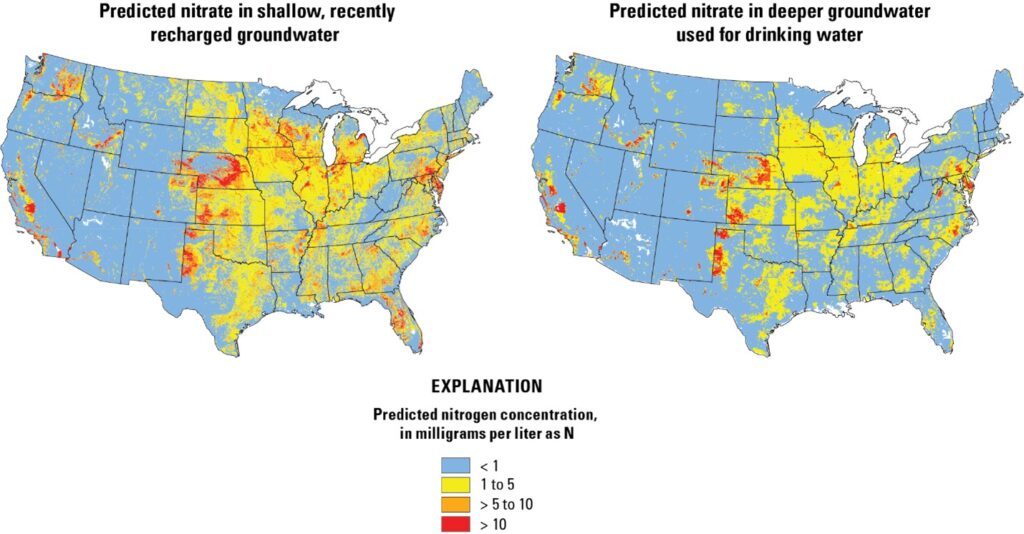April 2023 – Nitrate and nitrite are nitrogen-oxygen based chemicals which occur naturally in water, soil, air, plants, and the human body. There are also man-made sources of nitrate and nitrite, and these include fertilizers, food preservatives, pharmaceutical drugs, and explosives.
Nitrate and nitrite can be found in both groundwater and surface water, and are commonly detected during routine well water testing. Nitrate and nitrite become a concern in drinking water when levels exceed the limits (MCLs) set by the EPA.
The U.S. Environmental Protection Agency (EPA) has established the maximum contaminant levels (MCLs) for Nitrate & Nitrite in Drinking Water as follows:
• 10 mg/L for nitrate
• 1.0 mg/L for nitrite
Where are High Levels of Nitrate and Nitrite Commonly Found?
Nitrate and/or nitrite contamination can be caused by fertilizer runoff, septic tank waste/leaks, manure / animal waste, as well as erosion of natural deposits. Communities with large numbers of aging septic tanks and/or working farms are particularly vulnerable to high levels of nitrate/nitrite in soil, groundwater and drinking water.
Public water systems routinely test nitrate/nitrite levels, but private well owners must perform their own testing for these and other common contaminants in order to be sure that their tap water is safe to drink. As with many contaminants, you cannot see, smell, or taste nitrate/nitrite in drinking water.

Health Risks of Nitrate and Nitrite
Exposure to nitrate and nitrite mainly occurs through consuming food and water that contain these chemicals, however most people are not exposed to concerning levels. According to the World Health Organization, consumption of nitrates in drinking water is not considered a significant health risk to otherwise healthy adults in industrialized countries. Nitrate and nitrite have not been classified as carcinogenic by the EPA.
The real concern over nitrate in drinking water and subsequent established EPA water standards stem from a 1945 case study and related investigations which showed that infants who consumed baby formula mixed with nitrate-contaminated water were at risk of developing methemoglobinemia, also known as “blue-baby syndrome.”

This condition is caused when the body converts nitrates into nitrites, which then bind to hemoglobin, forming methemoglobin. Methemoglobin is unable to carry oxygen. The low levels of oxygen in the baby’s bloodstream cause the baby’s skin and nail beds to develop a blueish tint, which is often the first indicator, hence the name “blue-baby syndrome.”
In addition to blue skin and nail beds, babies with methemoglobinemia (blue baby syndrome) may also develop:
- fever
- difficulty breathing
- vomiting
- diarrhea
- lethargy
- increased salivation
- loss of consciousness
- seizures
- coma
- death (severe cases)
According to American Scientist, only two cases of “well-water methemoglobinemia” have been reported in the US since the mid-1960s, and zero since 2000. Improved water quality standards, public awareness, and an increase in breastfeeding may all be contributing to this decline.
How to Test for Nitrate and Nitrite in Water Samples
Environmental laboratories use Ion chromatography (IC) to test for nitrate and nitrite. IC is a form of liquid chromatography, capable of separating and measuring ionic species based on type, size, and resin interactions.
As the instrument runs, the sample passes through a chromatographic column, where the ions present in the sample are adsorbed by the constituents in the column. As an eluent liquid flows through the column, the adsorbed ions elute from the column, based on their affinity to the column material.
The different separation times of each ion is called the retention time. As the individual ions elute from the column, their concentrations can then be quantified. The results will be indicated on your environmental laboratory report.
Six Things Your Lab Wants You to Know About Nitrate / Nitrite Analysis
- Nitrate and Nitrite can each be reported separately on your lab report, or as a combined result (Total Nitrate).
- Your project needs will dictate your reporting preference, and must be noted on the Chain of Custody Form, as many aspects of the project will be affected depending on whether you choose ‘separate’ or ‘total’ (glassware, holding times, reporting limits).
- When you communicate your testing needs to the lab, they will provide you with the correct glassware (preserved or unpreserved bottles).
- For SEPERATE Nitrate / Nitrite results: • holding time is 48 hours and DO NOT preserve your sample(s) with sulfuric acid.
- For COMBINED Nitrate / Nitrite result (Total Nitrate): • holding time is 28 days and sample(s) MUST be preserved with sulfuric acid.
- Samples preserved with sulfuric acid require a dilution due to the interference caused by the acid, so the reporting limit is much higher.
The EPA released this update in November 2020, stating that if a sample exceeds 5 mg/L with a total nitrate and nitrite analysis, subsequent analysis should be conducted using nitrate specific methods.*
A Few Final Notes About Nitrate/Nitrite
If you want to, or are required to, test for nitrate and nitrite in drinking water samples, be sure to work with a laboratory that has been certified for the analysis by your state environmental services department.
If your lab analysis report indicates that your nitrate/nitrite levels exceed EPA MCLs, you should consider source reduction if possible, and/or consult companies near you for the most appropriate remediation option for your situation.
Nitrate / Nitrite Remediation Options Include
• Ion Exchange
• Reverse Osmosis
• Electrodialysis
• Water Distiller
(Note: boiling water and water softeners are not effective in removing nitrate)
Searching the internet for terms such as “water treatment company near me,” “removal of nitrate from well water,” and “nitrate remediation” will also provide information and resources to help address high nitrate/nitrite levels.
The Environmental Services Department in New Hampshire (NHDES) has set up a free web portal for homeowners to help understand drinking water lab results and treatment options for nitrate/nitrite and other common contaminants. You may use this free portal no matter your location, but your town or state environmental department may have similar resources available which will provide more relevant information specific to your geographical location.
*FMI on related public notification notices and recommendations related to the 2020 EPA nitrate/nitrite announcement visit this link.
Sources & Resources:
- US Environmental Protection Agency, EPA Chemical Contaminant Rule: Phase II/V Rules
- Agency for Toxic Substances & Disease Registry, Nitrate Nitrite Health Effects
- National Library of Medicine, “Blue Babies and Nitrate Contaminated Well Water
- NH Department of Environmental Services, Interpret Your Water Report
- USGS Maps for Nitrate Levels & Other Contaminants



